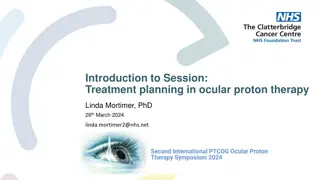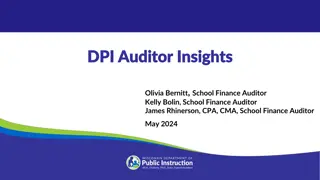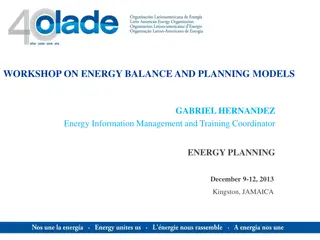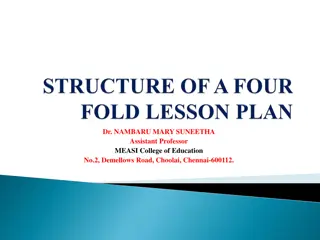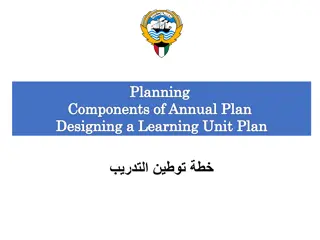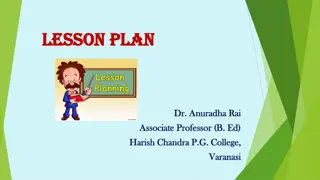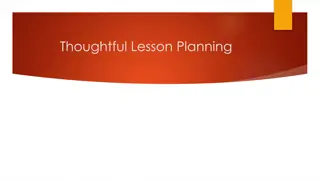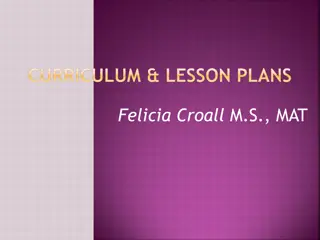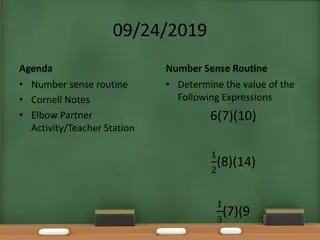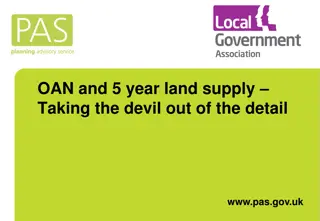Effective Lesson Planning Guidelines
Explore the key principles for effective lesson planning, starting with understanding the Infant Toddler Frameworks and progressing to choosing relevant benchmarks and writing measurable objectives. Learn how measurable objectives guide instructional activities and materials selection, focusing on student outcomes. Discover the importance of stating objectives in observable terms and how they drive assessment and evaluation. Find out the essential components of an objective: Audience, Behavior, Condition, and Degree (ABCD). Enhance your lesson planning skills with these insightful guidelines.
Download Presentation

Please find below an Image/Link to download the presentation.
The content on the website is provided AS IS for your information and personal use only. It may not be sold, licensed, or shared on other websites without obtaining consent from the author.If you encounter any issues during the download, it is possible that the publisher has removed the file from their server.
You are allowed to download the files provided on this website for personal or commercial use, subject to the condition that they are used lawfully. All files are the property of their respective owners.
The content on the website is provided AS IS for your information and personal use only. It may not be sold, licensed, or shared on other websites without obtaining consent from the author.
E N D
Presentation Transcript
Guidelines for Effective Lesson Planning Original Power Point from: http://www.uwsuper.edu/dl/loader.cfm?csModule=security/getfile&pageid=191952 Edited by Traci Johnston, Cindy Randolph, and Trude Puckett
The Infant Toddler Frameworks and the Frameworks for Three and Four Year Olds is where we need to start.
Choose the benchmark that relates to the task/activity you want to measure. What do you want to observe a child doing if they have met/accomplished this benchmark?
As you write measureable objectives, you should remember the following :
Measureable objectives guide the use of instructional activities
Measureable objectives guide the selection of the materials you choose.
Measureable objectives focus on learning outcomes for students, NOT actions by the teacher.
Measureable objectives are stated in terms of observable student outcomes. Children will understand the parts of a book. This is NOT a statement of an observable outcome. Understand is a verb that cannot be measured objectively.
The child will name the parts of a book when pointed to by the teacher 9 out of 10 times. This is a statement of an observable outcome.
Measureable objectives determine assessment and evaluation.
Each objective will contain four parts. It s as easy as ABCD! Audience Behavior Condition Degree
The audience is always the individual(s) for whom you are writing the objective. This should be explicitly stated in your objective. Only include one audience in each objective. Examples: The child will The infant will The toddler will... The preschooler will The kindergartener will
The infant will make eye contact with the caregiver s face when the caregiver talks 8 out of 10 times. (4.4.A) The toddler will point to an object in a book when the caregiver names the object 7 out of 10 times. (6.3.B) The preschooler will name an object in a book when the caregiver points to the object 8 out of 10 times. (3.3 and 3.4)
The behavior is always a verb/action that you can measure or observe objectively. Never use verbs like learn, understand, comprehend because they are hard to measure. Only include one behavior in each objective. Bloom s Taxonomy should be used to make sure you are choosing behaviors that promote different levels of learning.
Knowledge/Remembering Recalls previously learned information Knowledge Behaviors/Verbs/Actions Count Define Draw Find Identify Label Match Name Quote Recall Recite Record Select State Tell Sequence Write List Describe View Read
Comprehension/Understanding Comprehends/Understands the meaning of instructions or problems Comprehension Behaviors/Verbs/Actions Cite Conclude Estimate Explain Give examples Illustrate Locate Restate Review Summarize Classify Discuss Describe Report
Application/Applying Apply what has been learned in a new situation Application Behaviors/Verbs/Actions Illustrate Interpret Manipulate Operate Practice Predict Write Apply Change Choose Demonstrate Discover Dramatize Prepare Produce Show Sketch Solve
Analysis/Analyzing Separates materials or concepts into an organized structure that is understood Distinguishes between facts and opinions Analyze Behaviors/Verbs/Actions Analyze Contrast Illustrate Separate Categorize Examine Model Classify Experiment Question Compare Identify Select
Synthesis/Creating Put parts together to form a whole, with emphasis on creating a new meaning or structure Synthesis Behaviors/Verbs/Actions Develop Explain Plan Prepare Recreate Reorganize Rewrite Arrange Categorize Collect Combine Construct Create Design Summarize Tell Write
Evaluation/Evaluating Make judgments about the value of ideas or materials Evaluation Behaviors/Verbs/Actions Choose Compare Conclude Contrast Describe Estimate Evaluate Explain Interpret Relate Predict Rate Select
The infant will pull the cover off of an object that has been hidden 2 out of 3 times. ( 6.1.b) The toddler will point to big/little objects when named by the teacher 3 out of 4 times. (6.1.c.) The preschooler will recreate an auditory pattern through hand claps, foot taps, and leg flaps 7 out of 10 times. (3.12)
The condition identifies actions, materials and/or tools that will be accessible to the learner while his/her performance is evaluated. This should be explicitly stated in your objective. The condition should be the assessment used to evaluate learners.
The infant will respond to their name by turning their head 2 out of 3 times. (1.2.B) The toddler will respond to verbal communication by following one step directions 3 out of 4 times. (4.3.C) The preschooler will make appropriate predictions of whether objects can sink/float 8 out of 10 times. (3.23)
The degree is the level of proficiency required to indicate successful completion of the objective. This should be explicitly stated in your objective. Typically, you should not require your learners to be perfect to complete an objective, as this sets them up for failure. Examples: 2 out of 3 (66%) 3 out of 4 (75%) 9 out of 10 times (90%)
The Arkansas Frameworks uses the following terms: Not yet (0 30 %) 3 or less than out of 10 Emerging (31 -69%) 4 through 6 times out of 10 Consistently (7 0 100%) 7 through 10 times out of 10
The infant will reach for toys and/or objects when placed within reach 2 out 3 times. (5.2.A) The toddler will respond to the cries of another child by patting/hugging the child as an expression of concern 3 out of 4 times. (3.3.C) The preschooler will demonstrate independence by washing hands correctly without assistance 8 out of 10 times. (1.2)

 undefined
undefined











